- Fire Emblem Wyvern Rider - June 23, 2022
- Fire Emblem Assassin - June 8, 2022
- Fire Emblem Wyvern Lord - June 8, 2022
Intro
There are dozens of character classes in the Fire Emblem franchise. Over the years, many of these classes have seen alterations to their stat spread, special abilities, and how they function. Some of these alternations are drastic, while others are relatively minor. But not every character class has seen a lot of change. Some (for better or worse) have roughly been fundamentally the same since Shadow Dragon and the Blade of Light. One of those classes is the Fighter.
I’m a pretty avid axeman myself, something I can largely attribute to The Mark of Kri (You try playing that game and not falling in love with greataxes) and Fable. Because of this, when I played Fire Emblem for the first time, I had an obligation to see what Fighters can do.
So, how has one of Fire Emblem’s trademark ax-wielding classes fared in the 30+ years the series has been around? Let’s find out, shall we?
History Of The Fighter

The Fighter class made its’ debut in Fire Emblem: Shadow Dragon and the Blade of Light in 1990. The first three Fighters in the series were Barst, Bord, and Cord, with the latter two establishing the Fighter Duo Archetype. Fighters were initially limited to the usage of axes and did not have a promotion unit, which somewhat limited their viability in the late game. The Fighter would appear in follow-up Fire Emblem Gaiden, but not as the same class. In Gaiden, Fighter is the personal class of the main character Alm and uses swords instead of axes. It functions more like a fusion of the Mercenary and Lord classes than the ax-wielding Fighter we know today.
Axe-wielding Fighters were once again a thing in the third game, Mystery of the Emblem, as axe users. They still had yet to receive a promotion unit, and even worse, aren’t even available for the entirety of the game. Mystery of the Emblem consists of two Books, and Fighters are only playable in Book 1.
Fighters finally received some love in Genealogy of the Holy War. Renamed Axe Fighters (Not to be confused with Axe Knights), they finally got their promotion unit in the Warrior class. Their new promotion gave Axe Fighters access to Bows, granting them additional utility.
The Odd Man Out: Thracia 776
Intelligent Systems was still perfecting how character classes worked back in the 90s and made some odd changes to the Fighter class in Thracia 776.
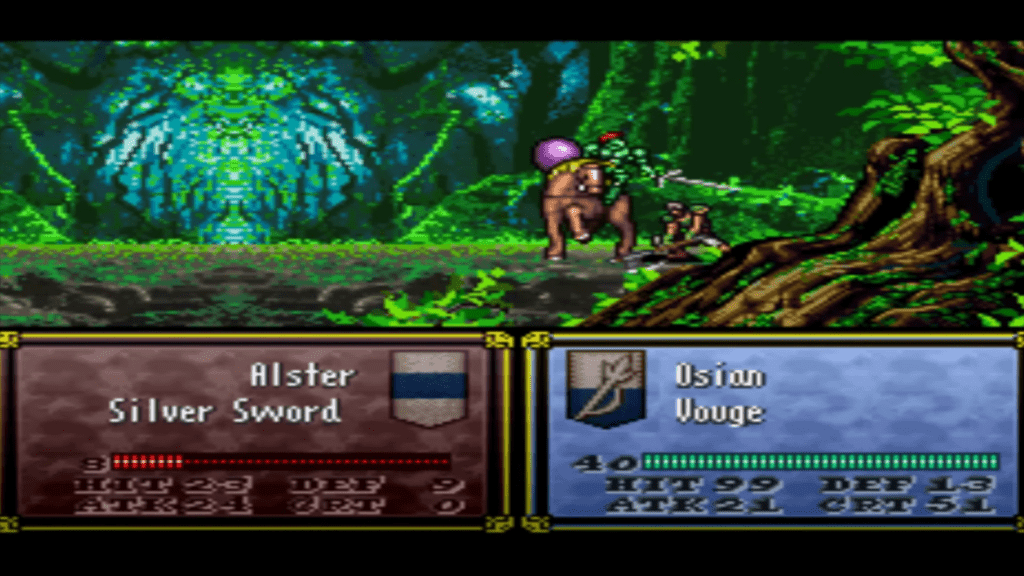
The Axe Fighter became a bizarre hybrid between the traditional Fighter and the Myrmidon. Instead of promoting to the Warrior class, Fighters promote to Heroes, which would become the promotion class for Mercenaries. As such, they gain access to Swords upon promotion instead of Bows.
The Warrior class still existed in Thracia 776, but as the promotion for the seldom playable Brigand class.
The Beginning Of The Modern Fighter
Intelligent Systems finally hit their stride with characters classes with the sixth entry in the Fire Emblem series, The Binding Blade. From this point forward, alternations to character classes are generally less drastic. The Fighter class is no exception.
In The Binding Blade and its sequel, The Blazing Blade, Fighters returned to their Genealogy of the Holy War form with some fine-tuning thrown in. They were again Fighters instead of Axe Fighters and promoted to Warriors instead of Heroes.
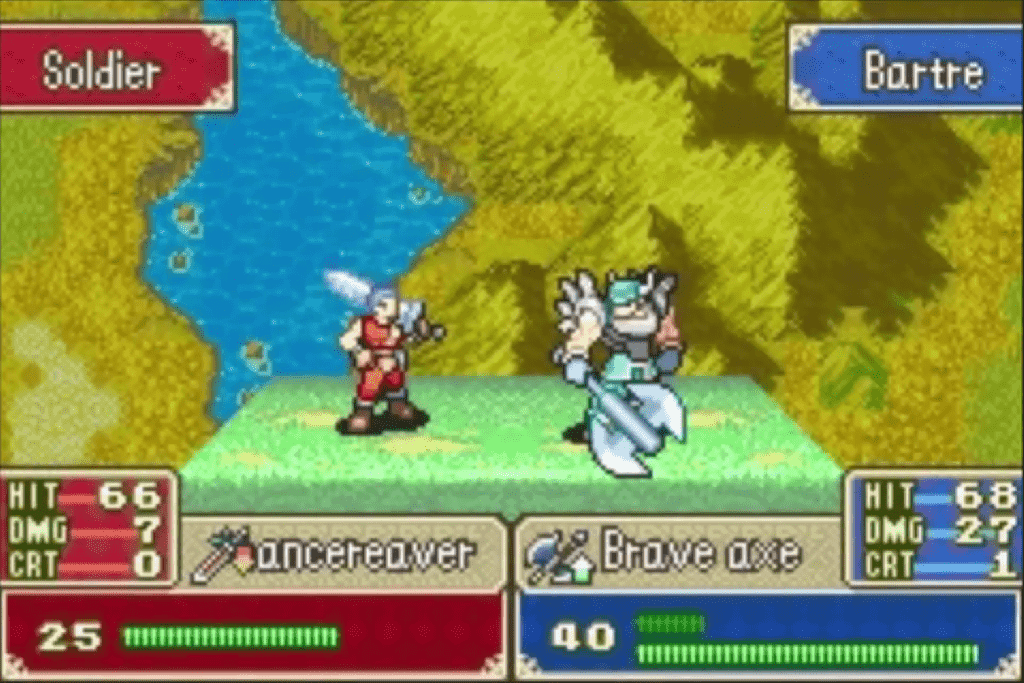
The Fighter remained unchanged in the final GBA Fire Emblem title, The Sacred Stones, with one exception. The Sacred Stones introduced a branching promotion system that allowed units to choose between two promotion classes. Fighters could still promote to Warriors and once again could become Heroes. The Fighter is also one of several tier 1 promotion options for Trainee character Ross.
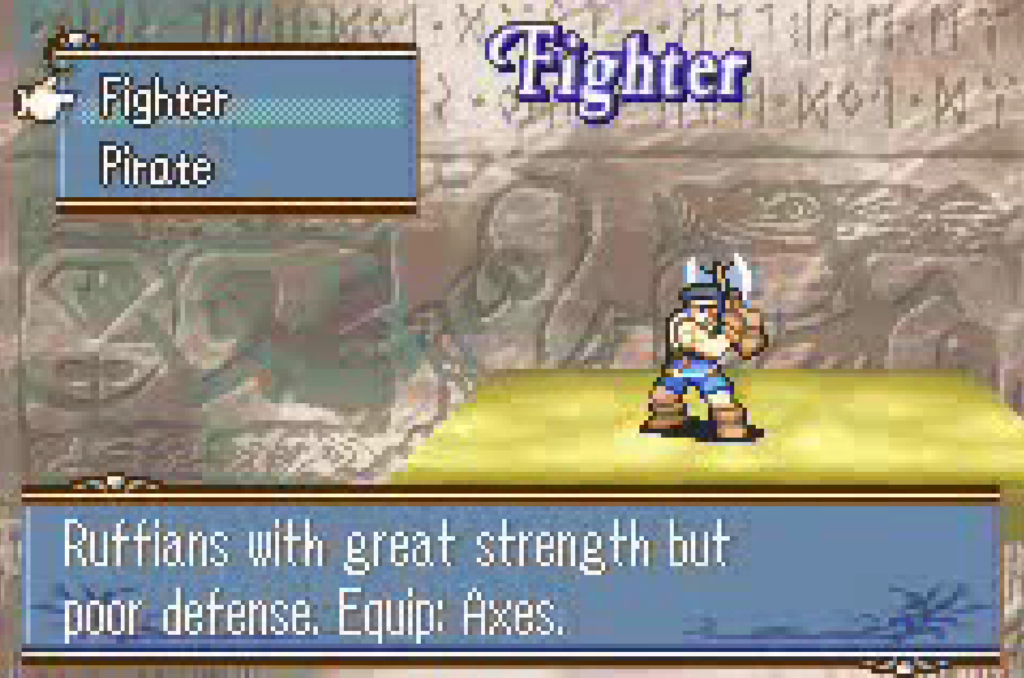
Nothing really changed to the Fighter Class in Path of Radiance, except for the inclusion of the Colossus Master Skill. Useable by Warriors and Berserker, Colossus increases Strength by a 1.25 multiplier upon activation. They received additional buffs in the follow-up, Radiant Dawn. Radiant Dawn had tier-three promotions, and Warriors could promote into the T3 class Reaver. Reavers gain access to Crossbows instead of Bows and receive the base Critical+ 5 skill. It’s a solid base skill that allows Fighters to deliver performance closer to Berserkers. The Colossus Master Skill returns as the Master Skill of the Reaver. Only it now increases Strength threefold when it activates.
Present-Day Fighter
Intelligent Systems made significant alternations to the Fighter class in Fates and Three Houses. For starters, it’s no longer just a boys’ club with characters like Charlotte and Rinkah emerging on the scene.
The other tier 1 ax-user classes like Pirates and Brigands are absent in Fates, and Fighters promote to either Berserkers or Heroes instead of Warriors. The Hoshidan classes of Oni Savage and Oni Chieftain are Fighters and Warriors in all but name and also use clubs instead of axes. Fighters and Warriors return in the recent Three Houses as potential promotion classes for Commoners and Nobles if they pass the Certification Exam at certain levels with the required rank in Axes.
The remakes of the first three games, Shadow Dragon, Shadow of Valentia, and New Mystery of the Emblem, brought those games up to the modern design standards, but that’s about it.
Until we get a new release, there goes the history of the Fighter class throughout the series. Let’s delve into the characteristics of Fighters to see what makes them tick.
What Makes A Fighter?
Fighters are ax-locked infantry units. They typically boast high HP and Strength growths and bases but are shaky everywhere else.

Their Speed, Skill, and Luck growths and bases usually range from average at best to poor. Their Defense growths and bases tend to be below average and Resistance abysmal. Their Resistance growths are some of the worst in the series. They have decent Constitution and mediocre Movement stats as is typical for infantry units. The heaviness of Axes will give them some problems. Combined with their average (At best) Speed and okay Constitution, they will seldom double enemies outside the early game. At worst, enemies will begin to double them often. Many Fighters with average Speed growths can keep up with enemies as the game progresses, but it’s easy for Fighters to get hard RNG-screwed. If you don’t get much Speed from leveling up, your Fighter will become one of the slowest units in your army.
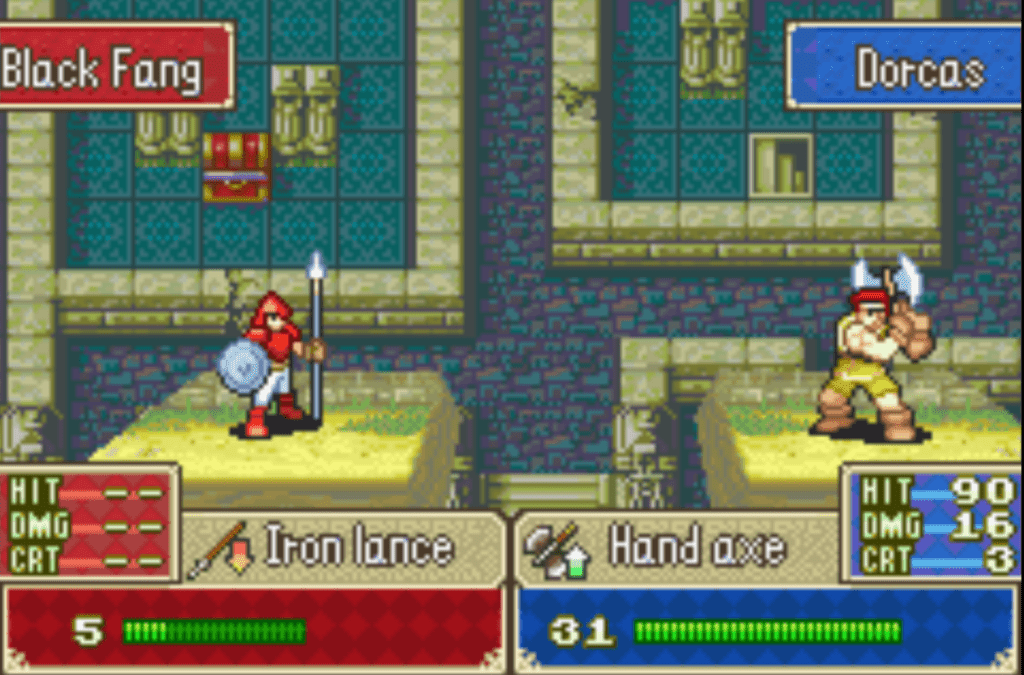
Thanks to their high Strength, Fighters tend to be the hardest hitters in your army when they join (Alongside Mercenaries with Blade weapons). On the hardest difficulty, they will be one of the few units that can chip down tanky enemies like Knights without using super-effective weapons like Hammers. You can use this to your advantage by having them set up kills for units with higher leveling priority. They usually start with an Iron Axe and a Handaxe, giving you additional ranged attacking options early on. Some will also come equipped with a Hammer, making them ideal for taking down Knights right out of the gate.
Despite their generally poor Defense and Resistance, they can effectively serve as tanks in the early game due to their high HP bases. Once you hit the mid-game, this is no longer a viable strategy as Fighters are not proper tanks.
The Fighter’s classic promotion class of the Warrior grants them access to Bows. They typically only receive an E rank in Bows upon promotion (Though not always, as lucharba in Thracia 776 gets a B rank). As such, they can only use the Iron Bow until you feed them a lot of kills. However, even with only the Iron Bow, they are deadly against enemy flying units thanks to their high Strength. Pre-promoted Warriors tend to be the best Bow-using Warriors in the series since they almost always start with higher than an E-rank in Bows.
The Axe is an overall heavy and inaccurate weapon, but Fighters benefit from the design choices of Intelligent Systems. Most Fire Emblem games feature a lot of Lance-wielding enemies, giving Fighters a notable advantage. Fighters may lack Defense, but they can swoop in and effortlessly one-shot many enemies, effectively making them something of a glass cannon class.
The Bord And Cord Archetype
Fighters that fit the Bord and Cord archetype are Fighters you recruit very early in the game. They typically come in pairs and start as some of your more hard-hitting units.
Bord Fighters are boisterous and seek to test their mettle in battle. Cord Fighters are the calm and collected type. They are usually duty-bound and fight purely for either country or family. Both Bord and Cord Fighters are often parts of mercenary companies and always related or best friends.
Bord and Cord Fighters also have a trademark appearance, with most of them sporting headbands, sleeveless shirts, and slacks. They tend to be rivals, though sometimes it’s a more one-sided rivalry than anything. For whatever reason, Intelligent Systems effectively abandoned the Bord and Cord archetype after The Sacred Stones.
How Many Playable Fighters Exist In Fire Emblem?
Surprisingly enough, the Fire Emblem series doesn’t have many Fighters. There have been 17 playable Fighters thus far (Not including characters who could become Fighters, like Ross).
- Barst (Shadow Dragon & the Blade of Light, Mystery of the Emblem, Shadow Dragon, New Mystery of the Emblem)
- Bord (Shadow Dragon & the Blade of Light, Mystery of the Emblem, Shadow Dragon, New Mystery of the Emblem)
- Cord (Shadow Dragon & the Blade of Light, Mystery of the Emblem, Shadow Dragon, New Mystery of the Emblem)
- lucharba (Genealogy of the Holy War)
- Osian (Thracia 776)
- Halvan (Thracia 776)
- Wade (The Binding Blade)
- Lot (The Binding Blade)
- Dorcas (The Blazing Blade)
- Bartre (The Blazing Blade)
- Garcia (The Sacred Stones)
- Boyd (Path of Radiance)
- Nolan (Radiant Dawn)
- Dice (Fire Emblem: Archanea Saga, New Mystery of the Emblem)
- Vaike (Awakening)
- Arthur (Fates)
- Charlotte (Fates)
How Many Playable Warriors Exist In Fire Emblem?
There are only nine playable Warriors in Fire Emblem (Not counting re-classing and all that).
- Dagdar (Thracia 776, Awakening)
- Bartre (The Binding Blade)
- Geitz (The Blazing Blade)
- Boyd (Radiant Dawn)
- Ymir (Shadow Dragon, New Mystery of the Emblem)
- Basilio (Awakening)
- Alois (Three Houses)
- Hilda (Three Houses)
Is The Fighter Class Good?

That’s going to be a no. A very hard no.
As much as I like Fighters, especially their design, I can’t pretend they don’t have a lot of issues. Where do I even begin?
Axes will generally have an advantage for most of any Fire Emblem game since Intelligent Systems loves Lance users. However, Fighters’ generally low Skill combined with generally poor Skill growths rates can be a problem. As you start using some higher-level Axes, they might be significantly inaccurate even against Lance-users. Fighters have terrible Defense and Resistance, so they aren’t great at taking hits past the early game. And since Axes as such heavy weapons, their Avoid is also terrible, meaning they won’t dodge much either.
The de-facto promotion of the Fighter is the Warrior class which traditionally gives them access to Bows. They start at the bottom with an E rank, meaning you have to feed them a ton of kills to get them to the ideal bare minimum rank of C (For Killer Bows). But that presents more problems.
The first problem is that Bows are not overly viable in Fire Emblem. Most consider Archers/Snipers the worst offensive class in the series since they can’t protect themselves in close quarters. Warriors already have a solid ranged option in Handaxes, so they do not need Bows. If you want a Bow user stronger and more durable than an Archer/Sniper, Nomadic Troopers or Bow Knights are superior options to Fighters. They will have a better Bow rank than Warriors and have access to swords, a more reliable weapon type. As mounted units, they also have far better movement.
But what really makes the Fighter class bad is its base stats and growth rates.
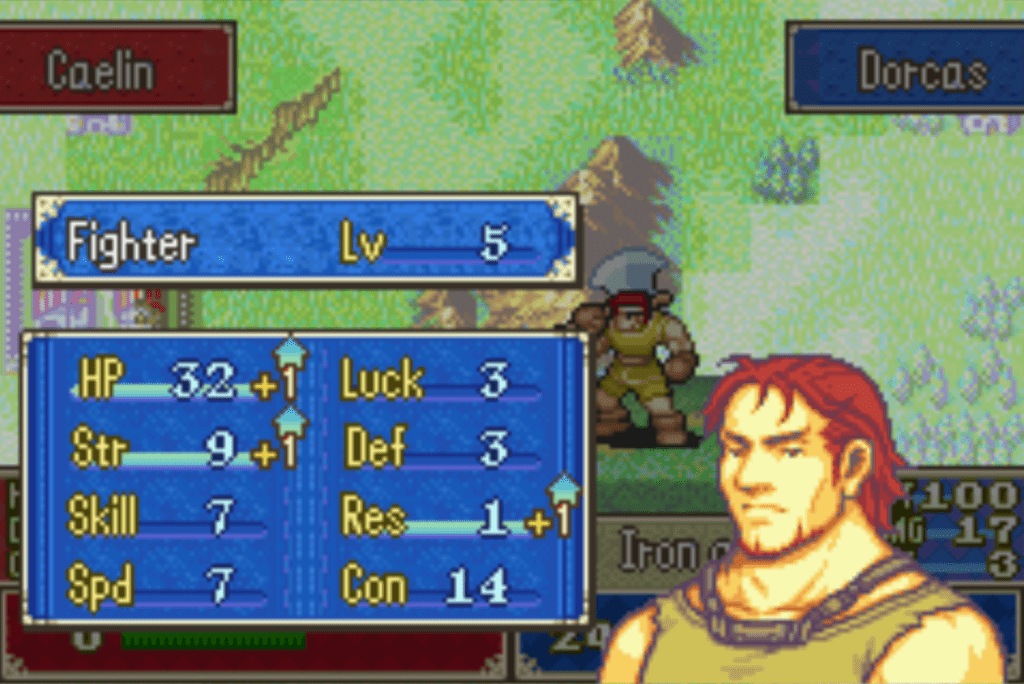
Luck is very important in Fire Emblem, and I don’t just mean the stat. I’m talking about how lucky you get when any character levels up. If the RNG Gods don’t favor you, any character can get screwed over and end up as a bad/subpar unit. No one is immune to this, not even top-tier classes like Cavaliers or Pegasus Knights. The Fighter is not a top-tier class, and as such, it is very easy for them to get screwed over by RNG.
To really drive home just how bad the Fighter class is, look at pre-promoted Warriors. Generally speaking, pre-promoted units are good/great when they show up but eventually, promoted units outclass them. But this is not the case with pre-promoted and promoted Warriors.
Pre-promoted Warriors tend to have growth rates roughly on the level of promoted Warriors, but where pre-promotes thrive is in their base stats. In many playthroughs, my pre-promoted Warriors have better stats in everything except Strength and HP, which matter the least. Pre-promotes are also the most viable if you want to use a Warrior with a Bow. Geitz in Fire Emblem 7 starts with a B rank in Bows, something I’ve never achieved with either Bartre or Dorcas. Even when you judge Warriors purely as Axe-users, Berserkers outclass them in utility and damage potential (Due to their Crit-focused abilities).
Pre-promotes also have an advantage over promoted Warriors thanks to them not needing promotional items. Warriors share Hero Crests with Heroes and Swordmasters, and there will almost never be a reason to promote a Fighter over a Mercenary or Myrmidon.
Numerous games in the series have either branching promotion options, a system to change classes, or both. And in all of those games, there’s little reason to keep your Fighter on the traditional path. The Fighter class has some fundamental problems. And while a few Fighter/Warriors break the norm, it’s not enough to prevent the class from being bottom-tier.
Who Is The Best Fighter In Fire Emblem?
The best Fighter in Fire Emblem is easily Osian from Thracia 776, one of the harder games in the series.
He might not look it at first due to underwhelming bases and growth rates, but Osian is one of the strongest characters in Thracia 776. And it’s all thanks to his personal weapon, Vouge. It is uncharacteristically light and accurate for an Axe and gives Osian an insane amount of crit chance. It has 60 uses and can attack from up to two spaces away. Even Berserkers would be impressed by how much Osian can crit.
FAQs
Question: Are Fighters worth using if they’re so bad?
Answer: In the early game, yes. Fighters hit very hard and have enough HP to sponge up damage and keep your frailer units safe in the first few chapters. Beyond that, you can honestly keep most of them at home. Their Resistance is atrocious beyond belief, and you’ll have to dedicate using all your Talismans on your Warriors just to give them decent Resistance.
Question: Who is the best Fighter after Osian?
Answer: The best Fighter after Osian is definitely classic Barst. He breaks the mold of traditional Fighter Growth rates and is respectable in every stat.
And by classic Barst, I mean the Barst in the first two games in the franchise, not their remakes. His growth rates took some heavy hits in Shadow Dragon and New Mystery of the Emblem. He’s still better than Bord or Cord but not nearly as good as he originally was.
Question: Who is your favorite Fighter?
Answer: It’s probably obvious from my name, but my favorite Fighter is the pre-promoted Warrior Geitz. He starts with B ranks in both Axes and Bows and is a pretty good pre-promoted unit, especially with Hard Mode bonuses. His only glaring weakness is his awful Resistance.
Conclusion
If you were looking for a video game franchise where Axe users shine, Fire Emblem isn’t it. Maybe in future installments, Intelligent Systems will address some of the core problems of the class to make Fighters more viable.
But keep this one thing in mind: You can use any character in a normal playthrough of Fire Emblem. So long as you understand how to play the game, you can field as many Fighters as you want. So if you’re like me and want to use the really likable but really awful Dorcas, you absolutely can. Part of video games is having fun, after all.
For more interesting readings about Fire Emblem check out:


